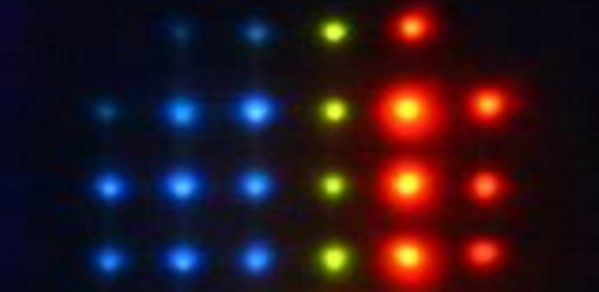
Researchers at the Centre of Molecular Materials for Photonics and Electronics (CMMPE) (part of the Department's Photonics Research Group) are leading the way towards the development of extremely high colour resolution laser displays using liquid crystal laser technology.
Laser displays are new to the market, and are currently being developed by a number of electronics manufacturers. In a laser display, pixels of light emission are generated from three separate red, green and blue (RGB) laser sources. They therefore have a much narrower spectral linewidth compared to the relatively broadband RGB sources from other display technologies, including CRT, plasma, LCD and even the latest organic light-emitting diode (OLED) displays. When these three narrow linewidth red, green and blue sources are combined in a laser display, they offer unprecedented depths of colour resolution over competing display technologies.
CMMPE has been performing extensive research into a new form of laser technology based on liquid crystals. In a recent article in Optics Express, they demonstrated a two-dimensional liquid crystal laser array, consisting of red, green and blue colours simultaneously being emitted from a single liquid crystal laser device, whilst being optically pumped with a single 430nm source. The article suggested that liquid crystal lasers could be used to replace the individual RGB lasers that are currently required in emerging laser displays. This would facilitate a reduction in the fabrication and materials cost of this currently fabrication-expensive technology. Furthermore, liquid crystal lasers are less likely to suffer from problems such as speckle, which are commonly associated with conventional laser display systems.
The liquid crystal laser itself is based on a similar device architecture as a conventional liquid crystal display. Liquid crystals are fast becoming an alternative medium for use as the feedback structure for a wide variety of miniature laser devices. Certain liquid crystal phases, in particular the chiral nematic phase, spontaneously self-organize to form a helical structure with a periodic refractive index. When combined with a gain medium, such as a fluorescent dye, the chiral liquid crystal provides sufficient feedback to generate lasing within a device of thicknesses less than a human hair. Unlike most conventional semiconductor lasers, the emission wavelength of a liquid crystal laser can be dynamically tuned using an applied voltage to alter the degree of periodicity of the macroscopic molecular structure. A further merit of this technology is that the emission can be chosen to be at any desired wavelength across the visible range through careful control, chemically, of the macroscopic material properties. A gradient in the periodicity of the liquid crystal structure can therefore be formed, which gives rise to simultaneous different emission wavelengths across the device. Such a feature is not readily achievable with existing laser technologies.
Liquid crystal lasers, however, are not merely restricted in their use to laser displays. Researchers at CMMPE are also developing applications for their use in infra-red medical diagnostic tools, telecommunication devices and holographic projection.
This research is on-going and is part of the four-year Basic Technology Research Grant 'COSMOS' funded by the EPSRC (Engineering and Physical Sciences Research Council) to develop a new generation of micron sized tunable coherent light sources based on ordered organic periodic structures. The research programme is a joint venture between research groups in the Department of Chemistry's Melville Laboratory, the Department of Engineering's Centre of Photonic Systems group and the Centre of Molecular Materials for Photonics and Electronics (CMMPE) group and the Department of Physics Optoelectronics group and Biological and Soft Systems group.
More information can be found on the Centre of Molecular Materials for Photonics and Electronics (CMMPE) group website or from Professor Harry Coles directly (hjc37@cam.ac.uk).
Articles on this research appeared in:
Optics Express (November, 2008)
Laser Focus World (January 2009)
Nature Photonics April 2009, Volume 3 No 4 pp177-236
Nature Photonics October 2008, Volume 2 No 10 pp581-638
Authors: Stephen Morris, Philip Hands, Sonja Findeisen-Tandel, Robert Cole, Timothy Wilkinson, Harry Coles

